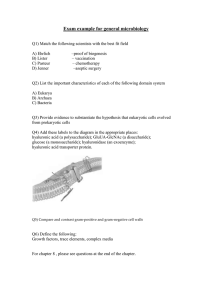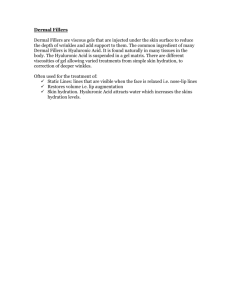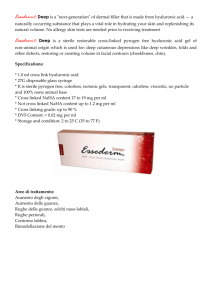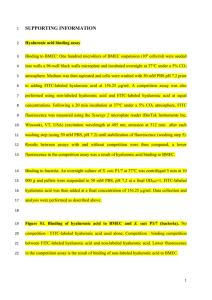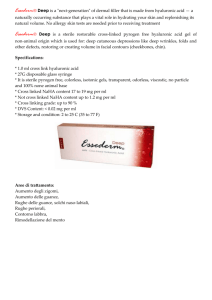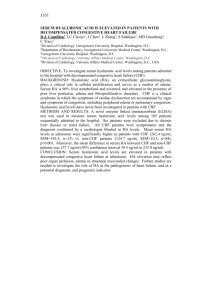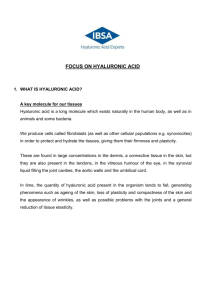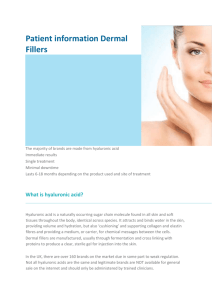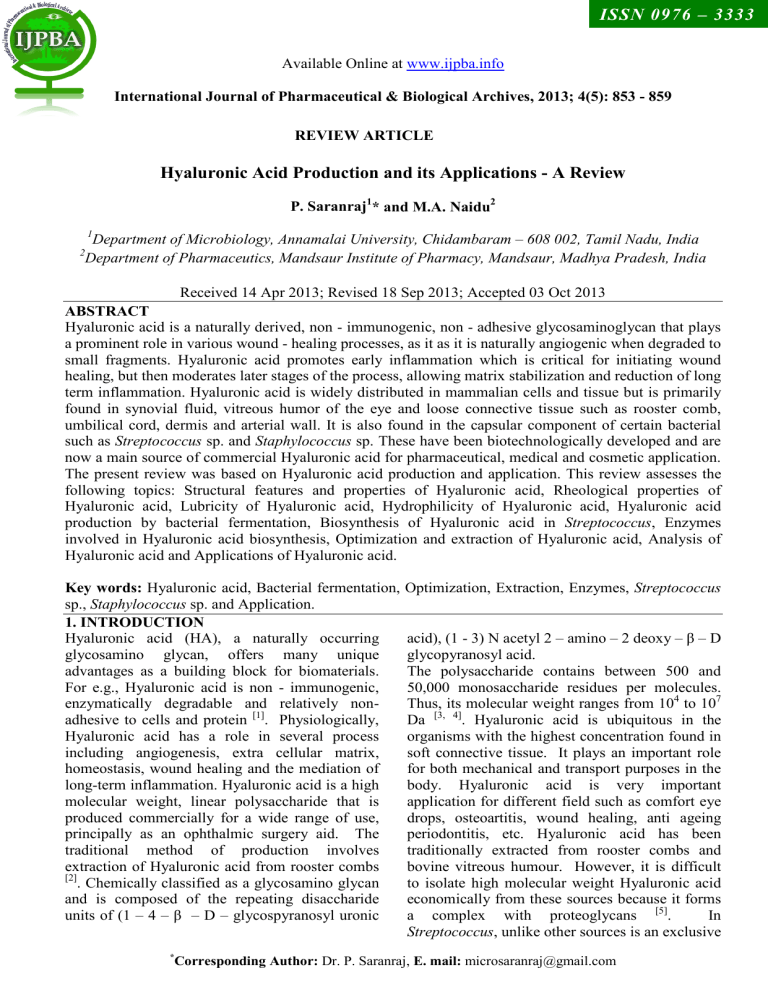
ISSN 0976 – 3333
Available Online at www.ijpba.info
International Journal of Pharmaceutical & Biological Archives, 2013; 4(5): 853 - 859
REVIEW ARTICLE
Hyaluronic Acid Production and its Applications - A Review
P. Saranraj1* and M.A. Naidu2
1
Department of Microbiology, Annamalai University, Chidambaram – 608 002, Tamil Nadu, India
Department of Pharmaceutics, Mandsaur Institute of Pharmacy, Mandsaur, Madhya Pradesh, India
2
Received 14 Apr 2013; Revised 18 Sep 2013; Accepted 03 Oct 2013
ABSTRACT
Hyaluronic acid is a naturally derived, non - immunogenic, non - adhesive glycosaminoglycan that plays
a prominent role in various wound - healing processes, as it as it is naturally angiogenic when degraded to
small fragments. Hyaluronic acid promotes early inflammation which is critical for initiating wound
healing, but then moderates later stages of the process, allowing matrix stabilization and reduction of long
term inflammation. Hyaluronic acid is widely distributed in mammalian cells and tissue but is primarily
found in synovial fluid, vitreous humor of the eye and loose connective tissue such as rooster comb,
umbilical cord, dermis and arterial wall. It is also found in the capsular component of certain bacterial
such as Streptococcus sp. and Staphylococcus sp. These have been biotechnologically developed and are
now a main source of commercial Hyaluronic acid for pharmaceutical, medical and cosmetic application.
The present review was based on Hyaluronic acid production and application. This review assesses the
following topics: Structural features and properties of Hyaluronic acid, Rheological properties of
Hyaluronic acid, Lubricity of Hyaluronic acid, Hydrophilicity of Hyaluronic acid, Hyaluronic acid
production by bacterial fermentation, Biosynthesis of Hyaluronic acid in Streptococcus, Enzymes
involved in Hyaluronic acid biosynthesis, Optimization and extraction of Hyaluronic acid, Analysis of
Hyaluronic acid and Applications of Hyaluronic acid.
Key words: Hyaluronic acid, Bacterial fermentation,
sp., Staphylococcus sp. and Application.
1. INTRODUCTION
Hyaluronic acid (HA), a naturally occurring
glycosamino glycan, offers many unique
advantages as a building block for biomaterials.
For e.g., Hyaluronic acid is non - immunogenic,
enzymatically degradable and relatively nonadhesive to cells and protein [1]. Physiologically,
Hyaluronic acid has a role in several process
including angiogenesis, extra cellular matrix,
homeostasis, wound healing and the mediation of
long-term inflammation. Hyaluronic acid is a high
molecular weight, linear polysaccharide that is
produced commercially for a wide range of use,
principally as an ophthalmic surgery aid. The
traditional method of production involves
extraction of Hyaluronic acid from rooster combs
[2]
. Chemically classified as a glycosamino glycan
and is composed of the repeating disaccharide
units of (1 – 4 – β – D – glycospyranosyl uronic
*
Optimization, Extraction, Enzymes, Streptococcus
acid), (1 - 3) N acetyl 2 – amino – 2 deoxy – β – D
glycopyranosyl acid.
The polysaccharide contains between 500 and
50,000 monosaccharide residues per molecules.
Thus, its molecular weight ranges from 104 to 107
Da [3, 4]. Hyaluronic acid is ubiquitous in the
organisms with the highest concentration found in
soft connective tissue. It plays an important role
for both mechanical and transport purposes in the
body. Hyaluronic acid is very important
application for different field such as comfort eye
drops, osteoartitis, wound healing, anti ageing
periodontitis, etc. Hyaluronic acid has been
traditionally extracted from rooster combs and
bovine vitreous humour. However, it is difficult
to isolate high molecular weight Hyaluronic acid
economically from these sources because it forms
a complex with proteoglycans [5].
In
Streptococcus, unlike other sources is an exclusive
Corresponding Author: Dr. P. Saranraj, E. mail: microsaranraj@gmail.com
P. Saranraj et al./ Hyaluronic acid production and its applications - A Review
IJPBA, Sep - Oct, 2013, Vol. 4, Issue, 5
synthesis of only one glycosaminlglycan.
Effectively, Hyaluronic acid is isolated at
relatively low cost and in high yields.
As a mimic of the embryonic environment,
exogenous Hyaluronic acid supplementation
promotes faster and more extensive regeneration
in adult injures.
This cumulative evidence
suggests that Hyaluronic acid is an ideal candidate
material for modulating wound healing. The cost
of high quality Hyaluronic acid is about $500 per
1000mg in injectable form (used in face lifts and
joint therapy) and $12 per 1000 mg in pills form.
Our body produces 1000s of dollars worth of
Hyaluronic acid every day. However, our cell
does not always produce Hyaluronic acid
efficiently. When Hyaluronic acid production
dwindles, it results in joint pain, mycofacial
rigidity, skin aging, dryness and wrinkles [6].
Hyaluronic acid has substantial medical and
biological importance, owing to its non –
immunogenic nature [7]. A highly viscous solution
of Hyaluronic acid can effectively retain moisture
and exhibit wound healing property and also act
as effective lubricant [8] and as a fluid
replacement, in pathological conditions. In
ophthalmic surgery such as cataract, glaucoma,
corneal transplant, retinal and vitreous surgery,
Hyaluronic acid is extensively used as a
supportive medium. Usage of high Molecular
weight @ Hyaluronic acid (1%) created the
conceit if viscosurgery [9]. The hydrophilic nature
makes it an ideal constituent in moisturization
lotions for cosmetic use [10].
Hyaluronic acid is a naturally occurring
Biopolymer, which serves important biological
functions in bacteria and higher animals including
humans. It was first isolated from the vitreous
body of the eye in 1934 by Karl Meyer, who
called it Hyaluronic acid. The term hyaluronan is
attributed Endre Balazs, who coined it to
encompass the different form the molecule can
take for example the acid form, Hyaluronic acid
and the salts such as sodium hyaluronate, which
form at physiological pH.
After 70 years, quite a lot is known about the
appearance of the hyaluronan molecule, its
behavior, its occurrence in different tissues and
body fluids, the manner in which it is synthesized
by the cells, metabolized and cleared from the
body, and the nature of some of the functions it
performs. The main purpose of this review is to
make readers aware of this increasingly important
biomaterial and to survey the techniques for
improving the production of Hyaluronic acid from
Streptococcus pyogenes, thereby modifying
synthetic material surfaces with hyaluronan.
2.STRUCTURAL
FEATURES
AND
PROPERTIES OF HYALURONIC ACID
Hyaluronic acid is comprised of linear,
unbranching, polyanionic disaccharide units
consisting of glucuronic acid (Glc UA) an N –
acetyl – glycosamine (Glc NAC) joined
alternatively by β 1-3 and β 1-4 glycoside bonds.
It is a member of the glycosaminoglycan family,
which includes chondroitin sulphate, dermatin
sulphate and heparin sulphate. Unlike other
members of this family, it is not found covalently
bound to proteins. Each repeating disaccharide
unit has one carboxyate group, four hydroxyl
groups and an acetamido group. Hyaluraonan
differs from the other major groups of
glycosaminoglycans in that it does not have
sulfate group [11].
Structure of Hyaluronic acid
Hyaluronic acid exists in a random coil
configuration,
which
is
polyanionic
at
physiological pH. At high molecular weights,
these random coils become entangled to form a
viscoelastic gel. Hyaluronan possesses a unique
set of characterestics: its solution manifests very
unusual rheological properties and is exceedingly
lubricious and it is very hydrophilic.
3.RHEOLOGICAL
PROPERTIES
OF
HYALURONIC ACID
Hyaluronic acid solutions are characteristically
viscoelastic and pseudoplastic. This rheology is
found even in very dilute solutions of the polymer
where very viscous gels are formed. In solutions,
the hyaluronan polymer chain takes on the form of
an expanded, random coil. These chains entangle
with each other at very low concentrations, which
may contribute to the usual rheological properties.
At higher concentrations, solutions have an
extremely high but shear dependent viscosity. A
1% solution is like jelly, but when it is put under
pressure it moves easily and can be administered
through a small bore needle. It has therefore been
called a “Pseudo-plastic” material [12].
854
© 2010, IJPBA. All Rights Reserved.
P. Saranraj et al./ Hyaluronic acid production and its applications - A Review
IJPBA, Sep - Oct, 2013, Vol. 4, Issue, 5
4. LUBRICITY OF HYALURONIC ACID
The extraordinary rheological properties of
hyaluronan solutions make them ideal as
lubricants. There is evidence that hyaluronan
separates most tissue surface that slide along each
other. This viscoelastic property of Hyaluronic
acid solution is controlled by the concentration
and molecular weight of the Hyaluronic acid
chains. The molecular weight of Hyaluronic acid
from different sources is polydisperse and highly
variable ranging from 104 to 107 Da. Hyaluronic
acid solution with this molecular weight is
extremely lubricious [13].
5. HYDROPHILICITY OF HYALURONIC
ACID
When incorporated in to a neutral aqueous
solution hydrogen bond formation occurs between
water molecules and adjacent carboxyl and Nacetyl groups. This imparts a conformational
stiffness to the polymer, which limits its
flexibility. The hydrogen bond formation results
in the unique water bonding and retention capacity
of the polymer. It also follows that the water
binding capacity is directly related to the
molecular weight of the molecule. Upto 6L of
water may be bound per gram of Hyaluronic acid
[14]
. This imparts the property that Hyaluronic acid
can interact preferentially with certain proteins
and cells.
Analytical data sheet of 1% Hyaluronic Acid
Organoleptic Analysis
Appearance
Color
Physical & Chemical Properties
pH (in solution at 1%)
Fine Powder
White
±
Solubility in water
6.5 1.0
Soluble
Solubility in Organic solvent
Average molecular weight
Insoluble
1000 kDa
Microbiological Analysis
Total plate count
Yeast mold
Escherichia coli
<100/g
0/g
0/g
6. HYALURONIC ACID PRODUCTION BY
BACTERIAL FERMENTATION
Hyaluronic acid has been traditionally extracted
from rooster combs and bovine vitreous humour.
However, it is difficult to isolate high molecular
weight Hyaluronic acid economically from these
sources because it forms a complex with
proteoglycans. Subsequent extraction and
purification processes result in an inherent,
molecular weight reduction [15]. The use of animal
derived biochemicals for human therapeutics is
being met with growing resistance, besides ethic
arguments, because of the risk of viral infection.
Industries have turned to bacterial fermentation
processes with the hope of obtaining
commercially viable polymer. In bacterial
fermentation, extra cellular polysaccharide is
released in to the growth medium and control of
polymer characteristics and product yields are
feasible. The amount of biopolymer that can be
produced by this route is theoretically unlimited.
7. BIOSYNTHESIS OF HYALURONIC ACID
IN Streptococcus
Streptococci are nutritionally fastidious anaerobes,
which produce lactic acid as a
by-product of
glucose metabolism. The Hyaluronic acid capsule
is a biocompatibility factor, formed as a mucoid
capsule around the cell, which enables the gram
positive bacteria to evade host immune defenses
and hence accounts for its characteristically high
virulence level.
In Streptococcus, Hyaluronic acid is produced as a
secondary metabolite and the production is
influenced by various factors that include genetic
as well as nutritional. Streptococcus produces
Hyaluronic acid both under aerobic and anaerobic
condition [16]. Certain strains of Streptococcus
produce Hyaluronic acid at a particular stage in
their life cycle and the same organism secrete
enzyme hyaluronidase at a later time, which
degrades the Hyaluronic acid produced earlier,
Hence, the strain selected for Hyaluronic acid
production were negative for hyaluronidase
activity and non pathogenic [17].
8. ENZYMES INVOLVED IN HYALURONIC
ACID BIOSYNTHESIS
• Phosphoglucomutase
• Pyrophosphorylase
• UDP – Glucose dehydrogenase
• Hyaluronate synthase
• Pyrophosphorylase
• Acetyl transferase
• Mutase
• Amidotransferase
9. OPTIMIZATION AND EXTRACTION OF
HYALURONIC ACID
Streptococcus fermentation was able to produce
Hyaluronic acid within average molecular weight
in the range of 1 - 4 MDa. The energy recovered
by these bacteria during anaerobic fermentation is
relatively low. Hence, the yield of Hyaluronic
acid from bacterial fermentation has been
characteristically low (0.1g/g glucose) [18].
855
© 2010, IJPBA. All Rights Reserved.
P. Saranraj et al./ Hyaluronic acid production and its applications - A Review
However, high yield of high molecular weight
Hyaluronic acid has been shown under aerobic
condition [19].
Several strategies were undertaken to increase the
life span of the synthase enzyme thereby
increasing the production of Hyaluronic acid from
Streptococcus pyogenes.
•
IJPBA, Sep - Oct, 2013, Vol. 4, Issue, 5
•
•
Increasing the energy resource for the cell
(glucose concentration) in the production
media.
Optimizing the pH of the medium and
Mutation – mutating the genes having the
negative effect on has gene (Hyaluronate
synthase producing gene).
There are two biosynthetic processes complete for
the limited resources namely carbon, nitrogen and
energy. At low specific growth rates the cell
directs more glucose – derived activated
precursors to Hyaluronic acid synthesis rather
than cell wall synthesis. The higher ATP yields
from aerobic glucose catabolism favors the
formation of UTP, which is required for the
formation of the two activated precursors of
Hyaluronic acid synthesis, The optimized pH
favors the energy yield from glucose, which may
be used to synthesis Hyaluronic acid [20]. The
Hyaluronic acid produced under optimized
condition was extracted by chloroform treatment
at room temperature [21].
10. ANALYSIS OF HYALURONIC ACID
Spectrophotometric method was used to estimate
the concentration of Hyaluronic acid present in the
sample. Hyaluronic acid in the sample react with
stains all reagents giving purple color. The color
developed was read at 640 nm [22].
Chromatographic
techniques
like
higher
performances liquid chromatography (HPLC),
size exclusion chromatography (SEC) coupled
with multi angle laser light scattering photometry
(Malls) were the other methods used to quantify
hyaluronic acid [23]. H1-NMR spectroscopy was
used to qualitatively verify the Hyaluronic acid.
The samples were dissolved in D 2 O and the
spectra were record using a varian inova 500
spectrophotometer [24].
Saranraj et al. [25] carried out optimization study
for Hyaluronic acid production at different pH and
different glucose concentration. Mutation studies
were also carried as a mean for improving the
Hyaluronic acid production. Hyaluronic acid
compounds were qualitatively analyzed through
HNMR spectroscopy. The Hyaluronic acid
capsule of the two strains were quantified
spectrophotometrically using stains all assay
method. Based on the optimization study at
different pH the maximum yield of Hyaluronic
acid was obtained at pH 6.9. The yields of
Hyaluronic acid from were Streptococcus
pyogenes parallelly increases with increase in
glucose concentration. The maximum Hyaluronic
acid production was observed at 1% glucose
concentration from Streptococcus pyogenes
marked under optimized pH 6.9. The production
gradually increases due to improved energy yield.
Mutation, with UV rays improves Hyaluronic acid
production from Streptococcus pyogenes after 10
minutes of exposure. UV mutation produces
positive effect on HAS gene.
11. APPLICARIONS OF HYALURONIC
ACID
Naturally occurring hyaluronic acid was found in
the tissues of higher animals, in particular as
intercellular space filler [26].
In the body
hyaluronic acid is synthesized by many types of
cells and extruded in to the extra cellular space
where it interacts with the other constituents of the
extra cellular matrix to create the supportive and
protective structure around the cells. It is present
as a constituent in all body fluids and tissues and
is found in higher concentration in the vitreous
humour of the eye and synovial fluids in the
joints.
In mammals, the highest reported
concentration is found in umbilical cord [27]. The
commercial source of hyaluronic acid is rooster
combs, which contain the polymer at a higher
concentration with respect to other animal tissues.
Another important source of Hyaluronic acid is
from microorganism, such as Gram - positive
Streptococci, where Hyaluronic acid appears as a
mucoid capsule surrounding the bacterium.
Over the past few years Hyaluronic acid has
become a buzzword synonymous with youth,
beauty, and pain relief and accelerated healing.
Our body produces thousands of dollars worth of
hyaluronic acid every day. However, our cells
don’t always produce Hyaluronic acid efficiently,
when Hyaluronic acid production dwindles, it
results in joint pain, myofascial rigidity, skin
ageing, dryness and wrinkles, In addition, slow
healing of wounds, muscles, tendons etc [28].
Hyaluronic acid and its derivatives formulated
through Streptococcal
fermentation (both
aerobically and anaerobically) has been largely
studied and applied in the biomedical arena. Its
high level of biocompatible has accentuated the
856
© 2010, IJPBA. All Rights Reserved.
P. Saranraj et al./ Hyaluronic acid production and its applications - A Review
IJPBA, Sep - Oct, 2013, Vol. 4, Issue, 5
appeal of this polymer. It has been used in
viscosurgery to allow surgeons to safely create
space between tissues. As a microcapsule it can be
used for targeted drug delivery. Viscosurgical
implants are constructed from hyaluronic acid [29].
Its viscoelastic character has been used to
supplement the lubrication in arthritic joints.
Because of its high water retention capacity this
extra cellular polysaccharide also occupies a niche
in the lucrative cosmetic market.
11.1. Ophthalmology
A field in which the purely physico - chemical
properties of high molecular weight Hyaluronic
acid, play a predominant role is ocular
microsurgery, specifically; it is extremely useful
in anterior or posterior segment eye surgery;
cataract extraction, with or without intraocular
lens implantation, kertoplasty and vitreous –
retinal surgery [30].
During eye surgery, Hyaluronic acid provides
effective protection to exposed tissues, such as the
corneal
endothelium
and
permits
the
reconstruction of anatomical form of the operation
site [31]. Exogenous Hyaluronic acid introduced
into the eye does not exert any negative effect on
post surgical intraocular pressure, nor does it
trigger any inflammatory sequelae in the
intraocular environment. In addition Hyaluronic
acid may leave in the eye as it is rapidly
eliminated by physiological mechanism, this
property is very useful. Hyaluronic acid solutions
are very similar to natural tears that are viscous
enough to adhere to the corneal epithelium when
the eyelids are open [32]. Hence, Hyaluronic acid
products have received the approval as drugs in
some countries and as surgical soft instruments in
others.
11.2. Osteoarthritis
Numerous
clinical
investigations
have
demonstrated the efficacy and safety of
Hyaluronic acid in the treatment of Osteoarthritis
of the knee and other large joints. Intraarticular
injection of Hyaluronic acid restores the
viscoelasticity of synovial fluid, normalize the
synthesis and inhibit the degradation of
endogenous Hyaluronic acid and relieve joint pain
[33]
. It also keeps swelling and swallowing at a
minimum, allowing cells to continually produce
Hyaluronic acid thereby increasing mobility and
strength.
11.3. Wound Repair
Many of the biological processes mediated by
Hyaluronic acid are central to the wound healing
process. Following injury, wound healing relies
on a series of tightly regulated sequential events
like inflammation, formation of granulation tissue,
reepithelization and remodeling. Hyaluronic acid
is likely to have a multifaced role in the mediation
of these cellular and matrix events [34]. Hence,
Hyaluronic acid is used for the treatment of acute
and chronic wounds such as abrasions, donarsites
and postoperative incisions, first and seconddegree burns, metabolic ulcers and pressure sores.
11.4. Dermatology and Cosmetics
The ageing of human skin is accompanied by
changes in Hyaluronic acid content and
metabolism with most dramatic decline being
observed after age 50. Low molecular weight
Hyaluronic acid can penetrate easily through the
skin and re-establish the Hyaluronic acid content.
When Hyaluronic acids are applied to the surface
of the skin, a viscoelastic film is formed. This film
inhibits penetration of foreign substances and
maintains the skin moisture [35]. Hence, the
commercial value of Hyaluronic acid far exceeds
that of other microbial extra cellular
polysaccharides. With an estimated world market
value of $US500 million, it is sold for upto $US
100.000 per Kilogram. Compare this with another
leading microbial extra cellular polysaccharides,
xanthan gum derived from Xanthomonas
campestris which sells for upto $US 11 per
Kilogram.
CONCLUSION
Hyaluronic acid is a substance that is naturally
present in the human body. It is found in the
highest concentrations in fluids in the eyes and
joints. The hyaluronic acid that is used as
medicine is extracted from rooster combs or made
by
bacteria
in
the
laboratory.
People take hyaluronic acid for various joint
disorders, including osteoarthritis. It can be taken
by mouth or injected into the affected joint by a
healthcare professional. The FDA has approved
the use of hyaluronic acid during certain eye
surgeries including cataract removal, corneal
transplantation, and repair of a detached retina and
other eye injuries. It is injected into the eye during
the procedure to help replace natural fluids.
Hyaluronic acid is also used as a lip filler in
plastic surgery. Some people apply hyaluronic
acid to the skin for healing wounds, burns, skin
ulcers, and as a moisturizer. There is also a lot of
interest in using hyaluronic acid to prevent the
effects of aging. In fact, hyaluronic acid has been
promoted as a "fountain of youth." However, there
is no evidence to support the claim that taking it
857
© 2010, IJPBA. All Rights Reserved.
P. Saranraj et al./ Hyaluronic acid production and its applications - A Review
by mouth or applying it to the skin can prevent
changes associated with aging.
IJPBA, Sep - Oct, 2013, Vol. 4, Issue, 5
REFERENCES
1. Chen – Ti Wang, M. D and Sheng –
MouHou, M. D. 2004. Therapeutic effects
of Hyaluronic acid on osteoarthritis of the
knee. Journal of Bone and Joint Surgery:
538 – 548.
2. Van Brunt, J. 1986.
Extraction of
Hyaluronic acid from rooster combs.
Biotechnology, 4: 780 – 782.
3. Fransson, L.A. 1985.
Mammalian
polysaccharide In: Aspinall O (Ed). The
Ploysaccharides Vol.3. Academic Press,
New York, 347 – 348.
4. Robyt, J. F. 1998.
Essentials of
carbohydrate chemistry springer, Berlin
Heidel berg, New York.
5. Jennie Baier Leach and Kathryn A.
Bivens. 2002.
Photocross linked
Hyaluronic acid Hydrogels:
Natural
biodegradable tissue engineering scaffolds.
Biotechnology and Bioengineering, 82:
5578 – 5589.
6. Ludwig, A and Vanooteghem, M. 1989.
Evaluation of sodium hyaluronate as
viscous vehicle for eye drops. Journal of
Pharmacy, 44 (6): 391 – 397
7. Sany Okputsa, Kornelia Jumel and
Stephen E. Harding. 2003. A comparison
of molecular mass determination of
Hyaluronic acid using SEC/MALLS and
sedimentation equilibrium.
European
Biophysics Journal, 32: 450 – 456.
8. Armstrong, D. 1977.
The molecular
weight properties of Hyaluronic acid
produced by Streptococcus zooepidemicus.
Chemical
engineering
(Brisbane:
University of Queensland).
9. Balazs, E. A. 1995. Hyaluronan
biomaterials: Medical application in Hand
book of Biomaterials and applications, ed.
DL Wise et al., (Newyork: Marcel
Dekkes), 2719 – 2741.
10. Balazs, E. A., Miller, D and Stegmann, R.
1979. International congress and first film
festival on intraocular implantation,
Cannes, Frances.
11. Bernard Weissamann and Karl Meyer.
1954. The structure of Hyaluronic acid
and of Hyaluronic acid from umbilical
cord. Journal of Biological Chemistry, 76:
1753 – 1756.
12. Laurel, N. E. 1999. Hylan gel composition
for precutaneous embolization. Journal of
Biomedical Materials Research, 25: 649 –
656.
13. Armstrong, D. 1977.
The molecular
weight properties of Hyaluronic acid
produced by Streptococcus zooepidemicus.
Chemical
engineering
(Brisbane:
University of Queensland).
14. Willoughby, D.A. 1994. Ed. First
international workshop on Hyaluronan in
Drug Delivery; Royal Society of medicine
press, UK.
15. Kitchen, J. R and Cysyk R. L. 1995.
Synthesis and release of Hyaluronic acid
by Swiss BT 3 Fibroblasts. Biochemistry
Journal, 309: 649 – 656.
16. Akasaka, H., Susumu, S., Yanagi, M.,
Fukushima, S and Mitsui, T. 1988. Journal
of Cosmetics and Chemistry, 22: 35 – 42.
17. Rosemans, Moses Fe, Ludowieg, J and
Dorfman, A. 1950. Journal of Biological
Chemistry, 203 – 213.
18. Goh, L. J. 1998.
Effect of culture
conditions on rates of intrinsic Hyaluronic
acid
production
by
Streptococcus
zooepidemicus. Chemical engineering
(Brisbane: University of Queensland).
19. Jennie Baier Leach and Kathryn A.
Bivens. 2002.
Photocross linked
Hyaluronic acid Hydrogels:
Natural
biodegradable tissue engineering scaffolds.
Biotechnology and Bioengineering, 82:
5578 – 5589.
20. Dougherty, B. A and Van de Rijn, I. 1994.
Molecular characterization of has A from
an operon for Hyaluronic acid synthesis in
group A Streptococci. Journal of
Biological Chemistry, 269: 169 – 175.
21. Fransson, L. A. 1985.
Mammalian
polysaccharide In: Aspinall O (Ed). The
Ploysaccharides Vol.3. Academic Press,
New York, 347 – 348.
22. Laurel, N. E. 1999. Hylan gel composition
for precutaneous embolization. Journal of
Biomedical Materials Research, 25: 649 –
656.
23. Sany Okputsa, Kornelia Jumel and
Stephen E. Harding. 2003. A comparison
of molecular mass determination of
Hyaluronic acid using SEC/MALLS and
sedimentation equilibrium.
European
Biophysics Journal, 32: 450 – 456.
858
© 2010, IJPBA. All Rights Reserved.
IJPBA, Sep - Oct, 2013, Vol. 4, Issue, 5
P. Saranraj et al./ Hyaluronic acid production and its applications - A Review
24. Jennie Baier Leach and Kathryn A.
Bivens. 2002.
Photocross linked
Hyaluronic acid Hydrogels:
Natural
biodegradable tissue engineering scaffolds.
Biotechnology and Bioengineering, 82:
5578 – 5589.
25. Saranraj, P., Sivakumar, S., Siva
Subramaniyan, J and Geetha, M. 2011.
Production,
optimization
and
spectroscopic studies of Hyaluronic acid
extracted from Streptococcus pyogenes.
International Journal of Pharmacology
and Biological Archives, 2(3): 886 -891.
26. Balazs, E. A. 1995. Hyaluronan
biomaterials: Medical application in Hand
book of Biomaterials and applications, ed.
DL Wise et al., (Newyork: Marcel
Dekkes), 2719 – 2741.
27. Balazs, E. A. 1979. Ultra pure hyaluronic
acid and the use thereof, U.S. path.4,
141,973.
28. CHI institute, HA Bulletin. 2004.
Inflammation and Hyaluronic acid an
antagonistic relationship.743 – 800.
29. Della Valle, F and Romeo, A. 1987.
Hyaluronic acid esters and their medical
and cosmetic uses and formulations EUR –
Pat. APPL.EP 216,453.
30. Tombs, M and Harding, S. E. 1998. An
introduction
to
polysaccharide
biotechnology.
Taylor and Francis,
London.
31. Ludwig A and Vanooteghem, M. 1989.
Evaluation of sodium hyaluronate as
viscous vehicle for eye drops. Journal of
Pharmacy, 44 (6): 391 – 397.
32. Chen – Ti Wang, M. D and Sheng – Mou
Hou, M. D. 2004. Therapeutic effects of
Hyaluronic acid on osteoarthritis of the
knee. Journal of Bone and Joint Surgery:
538 – 548.
33. John Chen, W and Abatangeio, Y. 1999.
Hyaluronic acid in wound repair. Wound
Repair and Regeneration: 79 – 89.
34. Willoughby, D. A. 1994. Ed. First
international workshop on Hyaluronan in
Drug Delivery; Royal Society of medicine
press, UK.
859
© 2010, IJPBA. All Rights Reserved.

